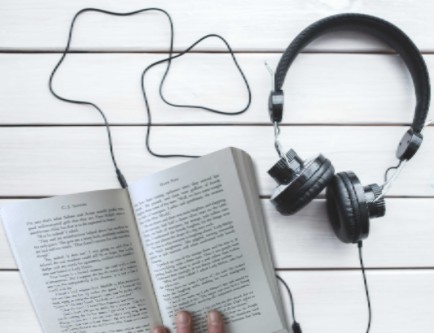

- © 2003 - 2024 Dynamix Productions, Inc. Contact Us 0



"Someone needs to buy a radio station, then play nothing but audio books, with a different genre of book played at set times. That way we can always have something new to read, no matter where we are."
Shana Chartier
We're wrapping up our series on the audiobook this month. In Part 1, we began our conversation with veteran actor and audiobook narrator Brad Wills. He talked technical details about finding the right studio, performance, editing, and quality. In Part 2, Brad shared his methods of character development and preparation, plus he had some tips for budding narrators. In this issue, we're looking at how an audiobook is actually produced, from recording and editing, to mastering and delivery.
Before any audiobook can be recorded, we have to plan out a schedule. An average book can be read aloud at 150 words per minute. This is only a starting point, as each book will vary in length because of a narrator's natural speed, type of book, amount of characters and dialog, etc. We also have to take the narrator's stamina into account. If an author is coming in to read their own work, it usually means that they don't do this audiobook thing for a living. We might budget two hours each day to begin with, and then slowly increase that over the following days. In contrast, a professional audiobook narrator can go two to three hours before breaking and coming back for another two or three.
While recording, the engineer will make obvious notes when mistakes are made. But other places to edit or adjust are noted as well, such as mouth noises, clicks, pauses, page turns, volume adjustments, or other unusual sounds that will take the listener away from the story. Because of technical distractions, it's very difficult for a lone engineer to follow along with the text and make sure every word is correct. With bigger budget audiobooks, there will be an additional producer or proof reader in each recording session.
Next, after all the edits are made, the producer, narrator, or other person will listen back for text and performance mistakes while closely following the book. Most audiobooks have errors during this phase, so follow-up sessions are scheduled so the narrator can punch in the corrections and the editor can correct editing errors. Then the audiobook is listened to once again by at least one more person, usually the author. Sometimes an additional proofreader will be employed in this phase as well. The whole process from beginning to end for a standard novel or non-fiction work may take three to six weeks to complete, and have five or more complete listen-throughs.
Once everybody signs off on the audiobook's read, final mastered files are sent to the distribution company, such as Audible. Although the book is not listened to for accuracy, engineers will spot check the files for technical and audio consistency. This phase can be challenging for the first time audiobook engineer because most large audiobook distribution companies have strict technical requirements to make certain that all their audiobooks play at the same perceived level.
It's important to not underestimate the difficulty in engineering and producing an audiobook. While most soundtracks are layered with music or sound effects, an audiobook is just a voice in a quiet room for several hours. It must sound as if the narrator made no mistakes, didn't move, didn't stop, or didn't turn a page. The background must be free of any distractions like thumps, air conditioners, traffic, voices, or other sounds. Any of these sounds will immediately pull the listener away from the narrative and make them aware of the distraction.
All recordings have some kind of low level noise, hiss, air, or room tone. When editing an audiobook, I will copy and paste short segments of "silent" room tone over clicks, pops, taps, thumps, gaps, and even odd breaths in order for the track to flow smoothly. Unlike editing voice for radio or TV spots where we remove breaths, we need to leave them in for audiobooks, otherwise it will sound like Robbie the Robot is reading. We also have to even out the loudness, or dynamics, of the overall audiobook. There are quiet passages that are interrupted by loud ones, but most of the time it's a pretty even narrative level over the course of the recording. Taking into account that most books are listened to while doing something else such as driving, walking, cleaning, etc. we have to compress the loud parts down and raise the quiet parts up a little. This ensures that the words will be heard over driving, traffic, household, and other noises in the listener's environment. With all this attention to levels and dynamics, you can probably figure out why I named my company Dynamix.
Audiobooks have become the next best thing to a good old paperback. Sometimes when I tell someone that I read a particular book, I have to pause and remember that it was an audiobook I listened to. A successful audiobook is one that has a good narrator and good production, so that our memories will be about the story.